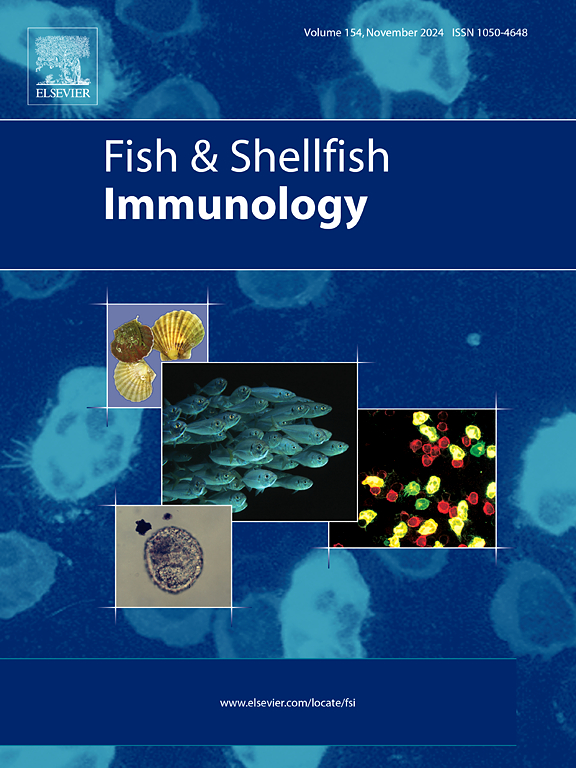CRISPR/Cas9-induced knockout of tumor necrosis factor-alpha-type I augments viral infection in zebrafish
IF 4.1
2区 农林科学
Q1 FISHERIES
引用次数: 0
Abstract
Tumor necrosis factor-alpha (TNF-α) is a pleiotropic cytokine with critical roles in inflammation, cell survival, and defense. As a member of the TNF superfamily, it exerts its effects by binding to transmembrane receptors and triggering various downstream signaling pathways. Although TNF-α′s involvement in antiviral responses in mammals is well-established, its role in teleost remains poorly understood. This study investigated the contribution of TNF-α1 to antiviral immunity in zebrafish using a tnf-α1(−/−) knockout (KO) line. We challenged both wild-type and tnf-α1(−/−) zebrafish with viral hemorrhagic septicemia virus (VHSV) at both embryonic and adult stages. Mortality was observed at 4 days post-infection (dpi) in tnf-α1-deficient adult fish challenged with 5 × 106 TCID50 (VHSV) and at 5 dpi in adult wild fish challenged with the same concentration. In addition, tnf-α1(−/−) KO adult fish reached the maximum mortality of 100 % at 20 dpi, whereas wild adult fish reached 54 % mortality at the same time point. This increased susceptibility to early mortality was associated with a higher viral burden and altered expression of key immune genes, including the pro-inflammatory cytokines il-6 and il-1β, the anti-inflammatory cytokine il-10, and interferon-related genes such as irf1 and ifn-γ. Our findings demonstrate the crucial role of TNF-α1 in antiviral defense mechanisms in zebrafish and provide valuable insights into the functional conservation of TNF-α signaling across vertebrate species. This knowledge may contribute to the development of strategies to combat viral diseases in fish.
CRISPR/ cas9诱导的肿瘤坏死因子α - I型敲除增加斑马鱼的病毒感染。
肿瘤坏死因子-α (TNF-α)是一种多效性细胞因子,在炎症、细胞存活和防御中起重要作用。作为TNF超家族的一员,它通过与跨膜受体结合,触发多种下游信号通路发挥作用。虽然TNF-α参与哺乳动物的抗病毒反应是公认的,但其在硬骨鱼中的作用仍然知之甚少。本研究利用TNF-α1(-/-)敲除(KO)细胞系研究了TNF-α1对斑马鱼抗病毒免疫的贡献。我们用病毒出血性败血症病毒(VHSV)攻击野生型和tnf-α1(-/-)斑马鱼的胚胎期和成虫期。用5×106 TCID50 (VHSV)侵染tnf-α1缺陷成鱼,感染后4天死亡,用相同浓度侵染野生成鱼感染后5天死亡。此外,tnf-α1(-/-) KO成鱼在20 dpi时最高死亡率为100%,而野生成鱼在同一时间点的死亡率为54%。这种对早期死亡的易感性增加与较高的病毒负荷和关键免疫基因的表达改变有关,包括促炎细胞因子il-6和il-1β、抗炎细胞因子il-10和干扰素相关基因如irf1和ifn-γ。我们的研究结果证明了TNF-α1在斑马鱼抗病毒防御机制中的关键作用,并为TNF-α信号在脊椎动物物种中的功能保护提供了有价值的见解。这一知识可能有助于制定对抗鱼类病毒性疾病的策略。
本文章由计算机程序翻译,如有差异,请以英文原文为准。
求助全文
约1分钟内获得全文
求助全文
来源期刊

Fish & shellfish immunology
农林科学-海洋与淡水生物学
CiteScore
7.50
自引率
19.10%
发文量
750
审稿时长
68 days
期刊介绍:
Fish and Shellfish Immunology rapidly publishes high-quality, peer-refereed contributions in the expanding fields of fish and shellfish immunology. It presents studies on the basic mechanisms of both the specific and non-specific defense systems, the cells, tissues, and humoral factors involved, their dependence on environmental and intrinsic factors, response to pathogens, response to vaccination, and applied studies on the development of specific vaccines for use in the aquaculture industry.
 求助内容:
求助内容: 应助结果提醒方式:
应助结果提醒方式:


